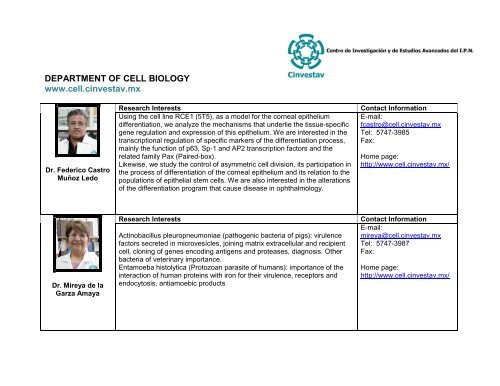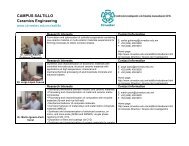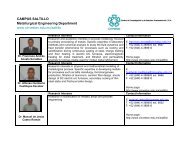DEPARTMENT OF CELL BIOLOGY www.cell.cinvestav.mx
DEPARTMENT OF CELL BIOLOGY www.cell.cinvestav.mx
DEPARTMENT OF CELL BIOLOGY www.cell.cinvestav.mx
You also want an ePaper? Increase the reach of your titles
YUMPU automatically turns print PDFs into web optimized ePapers that Google loves.
<strong>DEPARTMENT</strong> <strong>OF</strong> <strong>CELL</strong> <strong>BIOLOGY</strong><strong>www</strong>.<strong>cell</strong>.<strong>cinvestav</strong>.<strong>mx</strong>Dr. Federico CastroMuñoz LedoResearch InterestsUsing the <strong>cell</strong> line RCE1 (5T5), as a model for the corneal epitheliumdifferentiation, we analyze the mechanisms that underlie the tissue-specificgene regulation and expression of this epithelium. We are interested in thetranscriptional regulation of specific markers of the differentiation process,mainly the function of p63, Sp-1 and AP2 transcription factors and therelated family Pax (Paired-box).Likewise, we study the control of asymmetric <strong>cell</strong> division, its participation inthe process of differentiation of the corneal epithelium and its relation to thepopulations of epithelial stem <strong>cell</strong>s. We are also interested in the alterationsof the differentiation program that cause disease in ophthalmology.Contact InformationE-mail:fcastro@<strong>cell</strong>.<strong>cinvestav</strong>.<strong>mx</strong>Tel: 5747-3985Fax:Home page:http://<strong>www</strong>.<strong>cell</strong>.<strong>cinvestav</strong>.<strong>mx</strong>/Dr. Mireya de laGarza AmayaResearch InterestsActinobacillus pleuropneumoniae (pathogenic bacteria of pigs): virulencefactors secreted in microvesícles, joining matrix extra<strong>cell</strong>ular and recipient<strong>cell</strong>, cloning of genes encoding antigens and proteases, diagnosis. Otherbacteria of veterinary importance.Entamoeba histolytica (Protozoan parasite of humans): importance of theinteraction of human proteins with iron for their virulence, receptors andendocytosis, antiamoebic productsContact InformationE-mail:mireya@<strong>cell</strong>.<strong>cinvestav</strong>.<strong>mx</strong>Tel: 5747-3987Fax:Home page:http://<strong>www</strong>.<strong>cell</strong>.<strong>cinvestav</strong>.<strong>mx</strong>/
Dr. GuillermoElizondo AzuelaResearch InterestsAhR is a transcription factor that induces genes that code for CYP450s.Although it is considered part of a response from adaptation to exposure tochemicals, recent studies suggest that their functions include other <strong>cell</strong>ularprocesses different from detoxification. The objective of the laboratory is toidentify and characterize these processes through biochemical,pharmacological and biological <strong>cell</strong>ular and molecular analysis, as well asthe use of genetically modified mice and <strong>cell</strong> cultures. Current projects arefocused on determining the role of AhR in the regulation of the immunesystem and the ubiquitin-proteasome system.Contact InformationE-mail:gazuela@<strong>cell</strong>.<strong>cinvestav</strong>.<strong>mx</strong>Tel: 5747-5555Fax:Home page:http://<strong>www</strong>.<strong>cell</strong>.<strong>cinvestav</strong>.<strong>mx</strong>/Dr. Ricardo FélixGrijalvaResearch InterestsThe research work in the laboratory focuses on various aspects of neuronalvoltage-dependent calcium channels. To address the objectives of ourresearch, the laboratory uses a combination of techniques includingelectrophysiology (patch clamp), molecular biology (transfection of channelsin <strong>cell</strong> lines, directed mutagenesis), biochemistry of proteins and confocalmicroscopy. Some of the projects carried out at present, in the laboratoryare:Regulation by proteins that modulate the exocytosis.Structure, function and pharmacology of the α2δ subunit.Regulation by peptide and steroid hormones.Cloning and characterization of promoters.Characterization of calcium channels and GABAA receptors in the spinalcord.Study of mutations linked to family hemiplegic migraine.Contact InformationE-mail:rfelix@<strong>cell</strong>.<strong>cinvestav</strong>.<strong>mx</strong>Tel: 5747-3988Fax:Home page:http://<strong>www</strong>.<strong>cell</strong>.<strong>cinvestav</strong>.<strong>mx</strong>/
Dr. Leopoldo FloresRomoResearch InterestsImmune response in vivo mainly in animal models; or in humans when it isfeasible, with two basic approaches:From early interactions with antigens (Ags) in tissues of exposure or skin(skin, urogenital, gastrointestinal mucosa, etc), where specialized (dendritic)<strong>cell</strong>s capture and process Ags, to transport them to the niches oflymphocytes B and T (nodes, spleen, etc) where the effector responsebegins.Responses of lymphocytes T (activation, proliferation, cytotoxicity in vivo) toAgs as Dengue Virus, human papillomavirus, Mycobacterium tuberculosisand leprae; or responses of "conventional" B lymphocytes (germ centers) toplasma <strong>cell</strong>s, from birth to adulthood.Contact InformationE-mail: leflores@<strong>cinvestav</strong>.<strong>mx</strong>Tel: 5747-3984Fax:Home page:http://<strong>www</strong>.<strong>cell</strong>.<strong>cinvestav</strong>.<strong>mx</strong>/Dr. Francisco GarcíaSierraResearch InterestsCellular and molecular pathology of Alzheimer's disease and relateddementias.Neuropathology and molecular analysis of the tau protein, its conformationalchanges, endogenous proteolysis and interaction with other molecules in thebrain of patients with Alzheimer's disease (Ad) and other dementias.Formation of abnormal tau filaments in vitro, similar to those that occur inthe brain of subjects with Ad. Evaluation and comparison of properties of invitro polymerization of various pathological species of tau.Analysis of the toxicity of the truncated tau protein and the triple mutant oftau VLW in neuronal and non neuronal <strong>cell</strong> lines.Study on the neurotróphic and neuroprotective properties of the cerebrolisinin <strong>cell</strong>ular models of neuronal differentiation and glial subjected to thetoxicity of amyloid-β.Contact InformationE-mail: fgarciasierra@<strong>cell</strong>.<strong>cinvestav</strong>.<strong>mx</strong>Tel: 5747-3354Fax:Home page:http://<strong>www</strong>.<strong>cell</strong>.<strong>cinvestav</strong>.<strong>mx</strong>/
Dr. EnriqueHérnandez GonzálezResearch InterestsOur group has different lines of research, linked to the understanding of thevarious biochemical and physiological changes experienced by sperm thatenabled them to fertilize the egg, known as capacitation, acrosomal reactionand hipermotility.In the regulation of these processes we are investigating:the participation of caveolins, flotilins, lipid rafts and the cytoskeleton,its regulation by protein kinase of focal adhesion (FAK) and Rho (Cdc42),andthe participation of proteins associated with distrophins, utrophins,distrobrevins and spectrin.Another line of research is related to the participation of the CFTR and Cl-/HCO - exchangers in sperm capacitation and motility.Contact InformationE-mail:eothon@<strong>cell</strong>.<strong>cinvestav</strong>.<strong>mx</strong>Tel: 5747-3352Fax:Home page:http://<strong>www</strong>.<strong>cell</strong>.<strong>cinvestav</strong>.<strong>mx</strong>/Dr. José ManuelHernándezHernándezResearch InterestsOur research group has as a central topic of study: THE CYTOSKELETON.For more than 20 years we have studied the cytoskeleton in <strong>cell</strong> models thatinclude animal <strong>cell</strong>s, parasites and bacteria. We are currently focused on thestudy of the involvement of the cytoskeleton in Giardia intestinalis,particularly at the stages of Trophozoite to cyst, and the search formolecular targets for specific therapeutic drugs.We are also interestedin the immune response that develops the host against Giardia andvirus of veterinary interest.Contact InformationE-mail:manolo@<strong>cell</strong>.<strong>cinvestav</strong>.<strong>mx</strong>Tel: 5747-3355Fax:Home page:http://<strong>www</strong>.<strong>cell</strong>.<strong>cinvestav</strong>.<strong>mx</strong>/
Walid Kuri HarcuchResearch InterestsIdentification and analysis of genes of early expression for the induction andregulation of commitment to differentiation and phenotypic expression duringadipose differentiation of 3T3-F44A2 <strong>cell</strong>s. Characterization of adipogenicfactors as regulators of differentiation and development of adipose tissue.Study of the differentiation of human stem <strong>cell</strong>s in culture. Study of theprocesses of repair and regeneration of wounds compared to stem <strong>cell</strong>s(stem <strong>cell</strong>s).Contact InformationE-mail:walid@<strong>cell</strong>.<strong>cinvestav</strong>.<strong>mx</strong>Tel: 5747-3353Fax:Home page:http://<strong>www</strong>.<strong>cell</strong>.<strong>cinvestav</strong>.<strong>mx</strong>/Dr. Juan Pedro LunaAriasResearch InterestsStudy of the basal transcription machinery in the Protozoan parasiteEntamoeba histolytica. Isolation and characterization of the cytoplasmicorganelle containing DNA called EhkO in Entamoeba histolytica byproteomics. Isolation and characterization of the gene encoding the nuclear<strong>cell</strong> proliferation antigen (PCNA) of Entamoeba histolytica. Isolation andcharacterization of genes encoding DNA polymerases from Entamoebahistolytica. Identification of molecular biomarkers for diagnosis andprognosis of breast cancer by Proteomics. Development of diagnosticsystems that use nanotechnology. Production of recombinant proteins ofinterest for the development of vaccines for use in diagnosys, yeast,baculovirus and bacterial expression systems: specifically in humaninfluenza A H1/N1 and influenza avian H5/N2. Identification of proteinsassociated with tangles of the Tau protein in brains of patients withAlzheimer's disease using proteomics.Contact InformationE-mail:jpluna@<strong>cell</strong>.<strong>cinvestav</strong>.<strong>mx</strong>Tel: 5747-5512Fax:Home page:http://<strong>www</strong>.<strong>cell</strong>.<strong>cinvestav</strong>.<strong>mx</strong>/
Dra. Adela MújicaMirandaResearch InterestsBiology of reproduction. Study of proteins that regulate the dynamics of theactin cytoskeleton (Arp2, Arp3, WASp, profilins I and II and three GTPasesRhoA, RhoB, and Cdc42 small) in the Guinea pig sperm. Study of thenuclear matrix and the acrosomal matrix: protein composition and function.Presence and phosphorylation of transcription factors during the formationof the male pronucleus. Participation of ADAM15 protein in the process offertilization. Role of the non-glucolitic aldolase A and the interactions of thealdolase with proteins in the dynamics of actin in the sperm. Role ofcalmodulin in the decondensation of the nucleus of the Guinea pig sperm.Contact InformationE-mail:adelam@<strong>cell</strong>.<strong>cinvestav</strong>.<strong>mx</strong>Tel: 5747-3992Fax:Home page:http://<strong>www</strong>.<strong>cell</strong>.<strong>cinvestav</strong>.<strong>mx</strong>/Dr. FernandoNavarro GarcíaResearch InterestsThe research work in our laboratory focuses on the following topics:Cellular microbiology.Mucosal immune response to intestinal pathogens.Mechanisms of toxins action from Escherichia coli causing diarrhea.Pathogenic factors secreted by Gram- negative bacteria.Mechanisms of secretion of bacterial protein type III secretion system(autotransporters).Cell biology of membranes, vesicle trafficking and cytoskeleton.Contact InformationE-mail:fnavarro@<strong>cell</strong>.<strong>cinvestav</strong>.<strong>mx</strong>Tel: 5747-3990Fax:Home page:http://<strong>www</strong>.<strong>cell</strong>.<strong>cinvestav</strong>.<strong>mx</strong>/
Dr. José EduardoPérez SalazarDr. GuadalupeReyes CruzDr. José de JesúsSerrano LunaResearch InterestsMechanisms of signal transduction induced by components of extra<strong>cell</strong>ularmatrix (MEC) and free fatty acids (AGL), as well as their participation inmigration, invasion and proliferation in breast cancer.Pathways of signal transduction induced by components of MEC, inparticular the constituent of the basal lamina collagen type IV (Col-IV).AGL and Col-IV as inducers of proliferation, migration, invasion andepithelial/mesenchymal transition in mammary cancer <strong>cell</strong>s.Expression and/or activation of proteins related to the processes ofmigration and invasion, induced by Col-IV and AGL, Metalloproteinases,integrins, tetrapasnins and receptors with discoidin domains.The cytoskeleton as a regulator of signal transduction pathways mediatedby COL-IV and AGL.Research InterestsMolecular mechanisms of growth and angiogenic factors secretion. Signaltransduction by G protein-coupled receptors.Characterization of signaling networks activated by receptors coupled to Gproteins, expressed in tumor <strong>cell</strong>s, contributing to the process of formation ofnew blood vessels. Identification and characterization of macromolecularcomplexes promoting the secretion of angiogenic factors, with emphasis onprotein-protein interactions that determine the vesicular trafficking ofreceptors and the secretion of growth factors. Identification, by cloningtechniques based on the interaction between proteins, of new modulatorelements of the calcium sensor.Research InterestsCell Biology of carcinogenesis: Role of inflammation and senescence inhepato<strong>cell</strong>ular carcinoma. Cell Biology of the amoebiasis: role of cholesterolin the virulence of Entamoeba histolytica. Cell Biology of Entamoeba of freelife: the role of proteases in the virulence of the parasite.Contact InformationE-mail:jperez@<strong>cell</strong>.<strong>cinvestav</strong>.<strong>mx</strong>Tel: 5747-3991Fax:Home page:http://<strong>www</strong>.<strong>cell</strong>.<strong>cinvestav</strong>.<strong>mx</strong>/Contact InformationE-mail:guadaluper@<strong>cell</strong>.<strong>cinvestav</strong>.<strong>mx</strong> Tel: 5747-3989Fax:Home page:http://<strong>www</strong>.<strong>cell</strong>.<strong>cinvestav</strong>.<strong>mx</strong>/Contact InformationE-mail:jserrano@<strong>cell</strong>.<strong>cinvestav</strong>.<strong>mx</strong>Tel: 5747-5559Fax:Home page:http://<strong>www</strong>.<strong>cell</strong>.<strong>cinvestav</strong>.<strong>mx</strong>/
Dr. Saúl VillaResearch InterestsComprehensive study of the development of liver cancer.Projects:Differential gene expression during the development of cancer.Identification of genes related to the production of cancer.Study of the proteins and genes related to the production of cancer.Identification of protein markers of early of cancer.Involvement of oxidative stress in the induction of liver cancer.Redox signaling during the development of liver cancer.Chemoprevention: mechanism of action of substances that prevent livercancer.Study of the mechanism of action CAPEStudy of the mechanism of action of quercetin.Study of the mechanism of action of the celecoxib.Contact InformationE-mail:svilla@<strong>cell</strong>.<strong>cinvestav</strong>.<strong>mx</strong>Tel: 5747-3993Fax:Home page:http://<strong>www</strong>.<strong>cell</strong>.<strong>cinvestav</strong>.<strong>mx</strong>/





